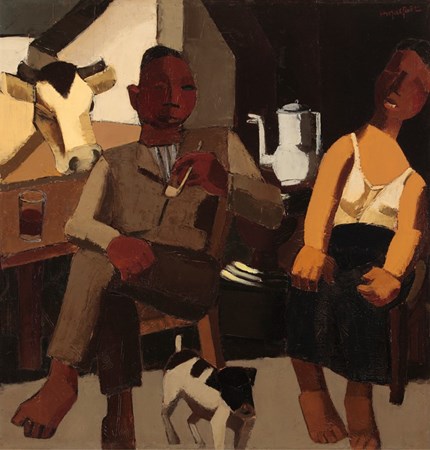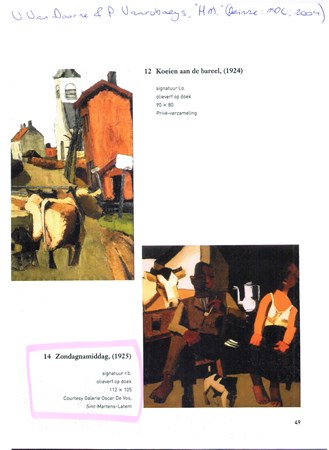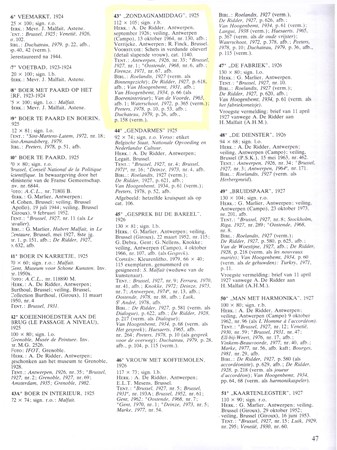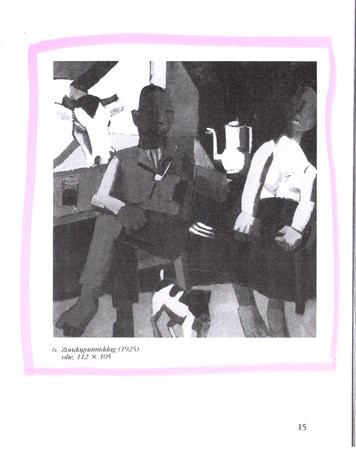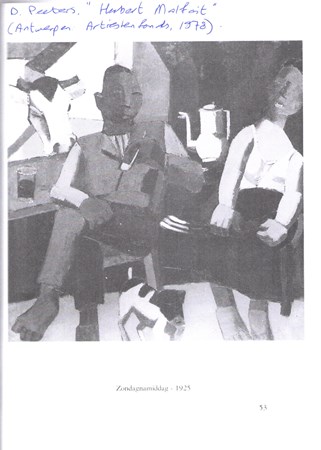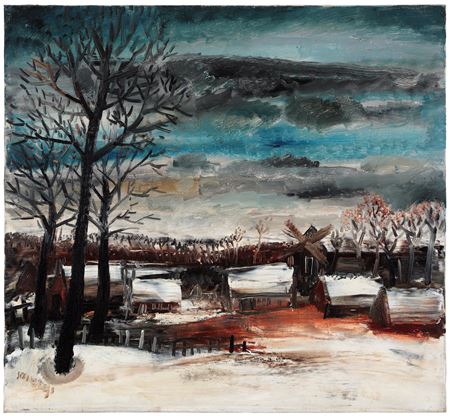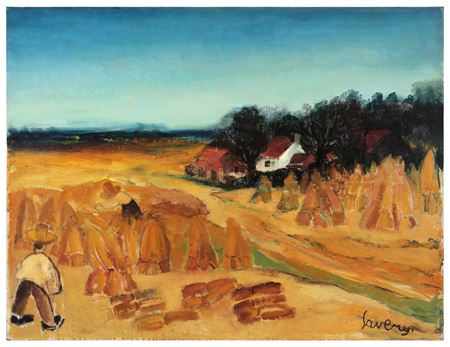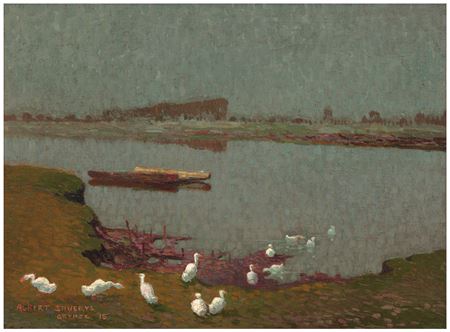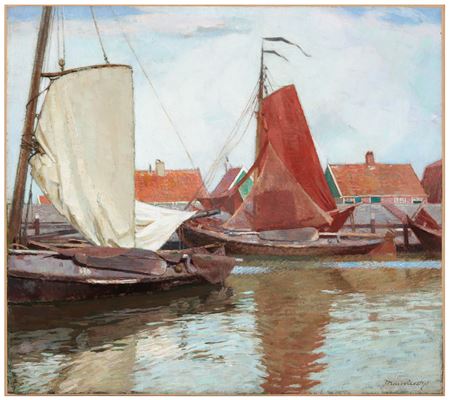- Antwerp, Galerie L'Oeuvre, Exposition de peinture et sculpture de l'Ecole Belge Moderne, 02-14.10.1926, no. 33.
- Brussels, 1927, no. 1.
- Ostend, MSK, Hubert Malfait, 1968, no. 6 (ill.).
- Firenze, Galeria Vaccarino, La Galleria Robert Finck di Bruxelles alla Gallaria Vaccarino, 09.09-10.10.1971, no. 67 (ill.).
- Deurle, Museum Leon De Smet, Hubert Malfait in 30 werken (1923-1931), 1988, no. 6.
- Ghent/ Deinze/ Deurle, MSK/ MuDeL/ MDD, Een zeldzame weelde. Kunst van Latem en Leiestreek 1900-1930, 2001, no. 225.
Hubert Malfait
(1898-1971)Sunday afternoon
1925Oil on canvas
113 x 108,5 cm
Framed: 134 x 130,5 cm
Signed above right: H. Malfait Contact Us
Literature


- Roelandts, O., 1927 (probably as 'Binnenzicht').
- De Ridder, A., "Hubert Malfait," in: Le Centaure (Brussel: 1927), p. 618 (ill.).
- Van Hoogenbemt, 1934, p. 66 (as 'Boereninterieur', ill.)
- Van de Voorde, U., Hubert Malfait (Brussel: 1963), no. 1 (ill.).
- Edebau, F., Hubert Malfait, exh. cat. (Oostende: MSK, 1968), nr. 6 (ill.).
- Galerie Robert Finck, Moderne schilderijen van 1850 tot heden, exh. cat. (Brussel: 1971) (ill.);
- Galerie Robert Finck, Van Emile Claus tot de hedendaagse kunst, exh. cat., nr. 6 (Brussel: s.a.), no. 30 (ill.).
- Waterschoot, H., "Kunstschilder Hubert Malfait, leven en werk," in: Kultureel Jaarboek van de Provincie Oost-Vlaanderen (Gent: 1972), p. 365 (prob.).
- Huys, P., Retrospectieve Hubert Malfait, exh. cat. (Deinze: MuDeL, 1973), foreword.
- Peeters, D., Hubert Malfait (Antwerpen: Artiestenfonds, 1978), p. 10, 53 (ill.).
- Duchateau, M., Hubert Malfait (Tielt: Lannoo, 1979), p. 26, 158 (ill.).
- D'Haese, J., Hubert Malfait in 30 werken (1923-1931), exh. cat. (Deurle: Museum Leon De Smet, 1988), p. 15, no. 6 (ill.).
- Boyens, P., Een zeldzame weelde. Kunst van Latem en Leiestreek 1900-1930 (Gent/Amsterdam: Ludion, 2001), p. 189, no. 225 (ill.).
- Vanrobaeys, P., S. Malfait, Hubert Malfait oeuvrecatalogus (Tielt: 1986) no. 43).
- Van Doorne, V., P. Vanrobaeys, Hubert Malfait 1898-1971, exh. cat. (Deinze: MDL, 2004).
- Pauwels, P.J.H., Als een fonkelenden spiegel (Sint-Martens-Latem: Galerie Oscar De Vos, 2019), 245 (ill.).
- De Ridder, A., "Hubert Malfait," in: Le Centaure (Brussel: 1927), p. 618 (ill.).
- Van Hoogenbemt, 1934, p. 66 (as 'Boereninterieur', ill.)
- Van de Voorde, U., Hubert Malfait (Brussel: 1963), no. 1 (ill.).
- Edebau, F., Hubert Malfait, exh. cat. (Oostende: MSK, 1968), nr. 6 (ill.).
- Galerie Robert Finck, Moderne schilderijen van 1850 tot heden, exh. cat. (Brussel: 1971) (ill.);
- Galerie Robert Finck, Van Emile Claus tot de hedendaagse kunst, exh. cat., nr. 6 (Brussel: s.a.), no. 30 (ill.).
- Waterschoot, H., "Kunstschilder Hubert Malfait, leven en werk," in: Kultureel Jaarboek van de Provincie Oost-Vlaanderen (Gent: 1972), p. 365 (prob.).
- Huys, P., Retrospectieve Hubert Malfait, exh. cat. (Deinze: MuDeL, 1973), foreword.
- Peeters, D., Hubert Malfait (Antwerpen: Artiestenfonds, 1978), p. 10, 53 (ill.).
- Duchateau, M., Hubert Malfait (Tielt: Lannoo, 1979), p. 26, 158 (ill.).
- D'Haese, J., Hubert Malfait in 30 werken (1923-1931), exh. cat. (Deurle: Museum Leon De Smet, 1988), p. 15, no. 6 (ill.).
- Boyens, P., Een zeldzame weelde. Kunst van Latem en Leiestreek 1900-1930 (Gent/Amsterdam: Ludion, 2001), p. 189, no. 225 (ill.).
- Vanrobaeys, P., S. Malfait, Hubert Malfait oeuvrecatalogus (Tielt: 1986) no. 43).
- Van Doorne, V., P. Vanrobaeys, Hubert Malfait 1898-1971, exh. cat. (Deinze: MDL, 2004).
- Pauwels, P.J.H., Als een fonkelenden spiegel (Sint-Martens-Latem: Galerie Oscar De Vos, 2019), 245 (ill.).
Exhibitions


Provenance


- André De Ridder, Antwerp, September 1926
- Campo, Antwerp, 1964, no. 130 (ill.)
- Verrijcke, Antwerp
- Robert Finck, Brussels
- Campo, Antwerp, 1964, no. 130 (ill.)
- Verrijcke, Antwerp
- Robert Finck, Brussels
Description


After his studies at the Ghent academy, Hubert Malfait quickly became part of the modernist milieu in Antwerp and Brussels. In the period 1923-1925 Malfait paints some monumental figure pieces with an extremely sculptural structure. Of this series, Sunday afternoon is the most convincing composition. Sundays and public holidays are the historical cradle of Flemish entertainment life. In the twenties, Sunday was the only day for many to relax. In this interior, a farmer's couple is proposed that enjoys their Sunday rest. It shows how in a small moment the highest happiness can be found. The farmer smokes his pipe relaxed and has a glass of brown beer within reach. Next to him is his wife resting with her hands on her lap. Between them the stew with a can of coffee. A dog lays at his feet, which is a traditional symbol of loyalty in painting. The biotope of the couple is highlighted in the left by the view of the courtyard of the farm. Outside, the cow controls the square of the window. The coffee pot, a loving wife, a loyal dog and the good-natured cow are part of the daily life of the farmer. The living environment of the farm couple is reduced to geometric areas. In the cylindrical structure of the characters and the animal, the painter is related to the primitivism of the international avant-garde. Malfait distinguishes itself by spicing the strict volume effect with mild humor. After all, in the composition it seems as if the cow is going to get her head through the window and enjoy a lazy Sunday afternoon. The enclosed compact space is displayed in full earth colors. Precisely this combination of avant-garde elements and a Flemish gentleness gives Malfait a very special place in Flemish expressionism. A strong sense of relaxed satisfaction, security and intimacy is displayed both in an iconographical and compositional way and through use of color. In addition to a mirror of the outer life, Sunday afternoon is also an internal reflection of the fascinating 'roaring twenties'. It makes this painting a crucial work of art in the Malfait's oeuvre.
You May Also Like




